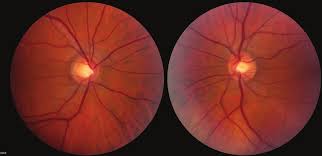The visual field has a blind or blur spot called a scotoma. Other areas around this spot appear to be normal. The most affected sites of scotoma are either the periphery or center of the vision. Scotomas can occur in one or both eyes and they can be clustered, isolated, or spread out.
Centrocecal scotoma is common with macular degeneration. This means that the central visual field is impaired, thus the name implies. The rods and cones are also known as light-sensing cells that are located in the retina’s center and start degenerating causing macular degeneration.
How do scotomas occur? Well! The answer is simple, the central area of the retina is called the macula and its location is right behind your eyeball. The retina is responsible to transmit light through the optic nerve to the brain.
These layers of cells along with other supporting cells deteriorate over time which leads to blurry or blind spots in the middle of the vision. This is known as a centrocecal scotoma.
Centrocecal Scotoma Symptoms
Age-related macular degeneration is a common cause of Centrocecal scotoma. In this scotoma, the central vision is severely impaired whereas the peripheral vision remains normal, which is a bit frustrating as we are more reliant on the central vision for our daily activities.
The blind spots have different types and it solely depends on the area where the vision is lost. When sharp central vision deteriorates, patients would not be able to see clearly what is in front of them.
When the macula is damaged, which is a tiny spot behind the eye, the photoreceptor cells die leading to loss of vision. Moreover, the symptoms of Centrocecal scotoma include the growth of abnormal blood vessels, excessive leaking of fluids from these vessels causing degeneration of the cells. If left untreated the blind spot enlarges and can cause permanent loss of sight in severe cases. On the other hand, the scotomas in the peripheral part of the vision usually go unnoticed.
Centrocecal Scotoma Causes
Multiple causes can progress or become the reason for centrocecal scotoma.
● Multiple sclerosis which is a demyelinating disease can damage the nerves in the retina due to which a patient might suffer from centrocecal scotoma.
● Hypertension
● Intake of toxic substances which usually include ethambutol, quinine, and methyl alcohol
● Nutritional deficiencies are a major cause too
● Vascular blockages in the optic nerve or retina are considered a major cause
● Brain injury and stroke can be a leading cause as well
● Aging can lead to macular degeneration
● Migraine
● The rare cause can be due to surgery, but often it is reversible
● Pituitary gland tumors can interfere with the optic blood supply or compress the nerve
● Severe preeclampsia in pregnant women can be a cause for the development of scotoma.
● Malignant hypertension can increase intracranial pressure which can be harmful to the optic nerves
● Sometimes the centrocecal scotoma is drug-induced. These drugs include aminoglycoside antibiotics like streptomycin
Centrocecal Scotoma Treatment
To diagnose scotoma or the underlying cause the ophthalmologist will refer the patients to go through automated visual field tests and dilated eye exams. The visual test will help to identify the specific areas which are causing the loss of vision.
The retina and the optic nerve are closely examined by the eye doctor in a dilated eye exam. The pupils are dilated with drops and the scans help to diagnose the scotoma.
Now let’s talk about the treatment. The treatment options of centrocecal scotoma depend on the cause and type of spots in the vision. If the scotoma is associated with the migraine headache, there is no such treatment. The patient is advised to take painkillers and wait for 30 minutes.
Managing the conditions like hypertension, stress can eliminate a few symptoms caused by Centrocecal scotoma. Furthermore, If glaucoma, diabetes, macular degeneration, or neurological problems are the root causes of centrocecal scotoma, then there is no definite and accurate treatment for this condition.
Scotoma-related vision loss can be managed by prescribing low vision aids, which are easily available. Urgent medical care should be sought if any individual experience these signs or symptoms,
● Nausea
● Dizziness
● Disoriented
● Weakness of muscles
● Difficulty in speaking or slurred speech
● Chronic headache
● Limbs and face numbness
● Head or injury of an eye leading to partial or full blindness
● An annual comprehensive eye exam is vital to prevent vision problems or scotoma in case you are suffering from diabetes or any other serious health condition.
 Health & Care Information
Health & Care Information 


